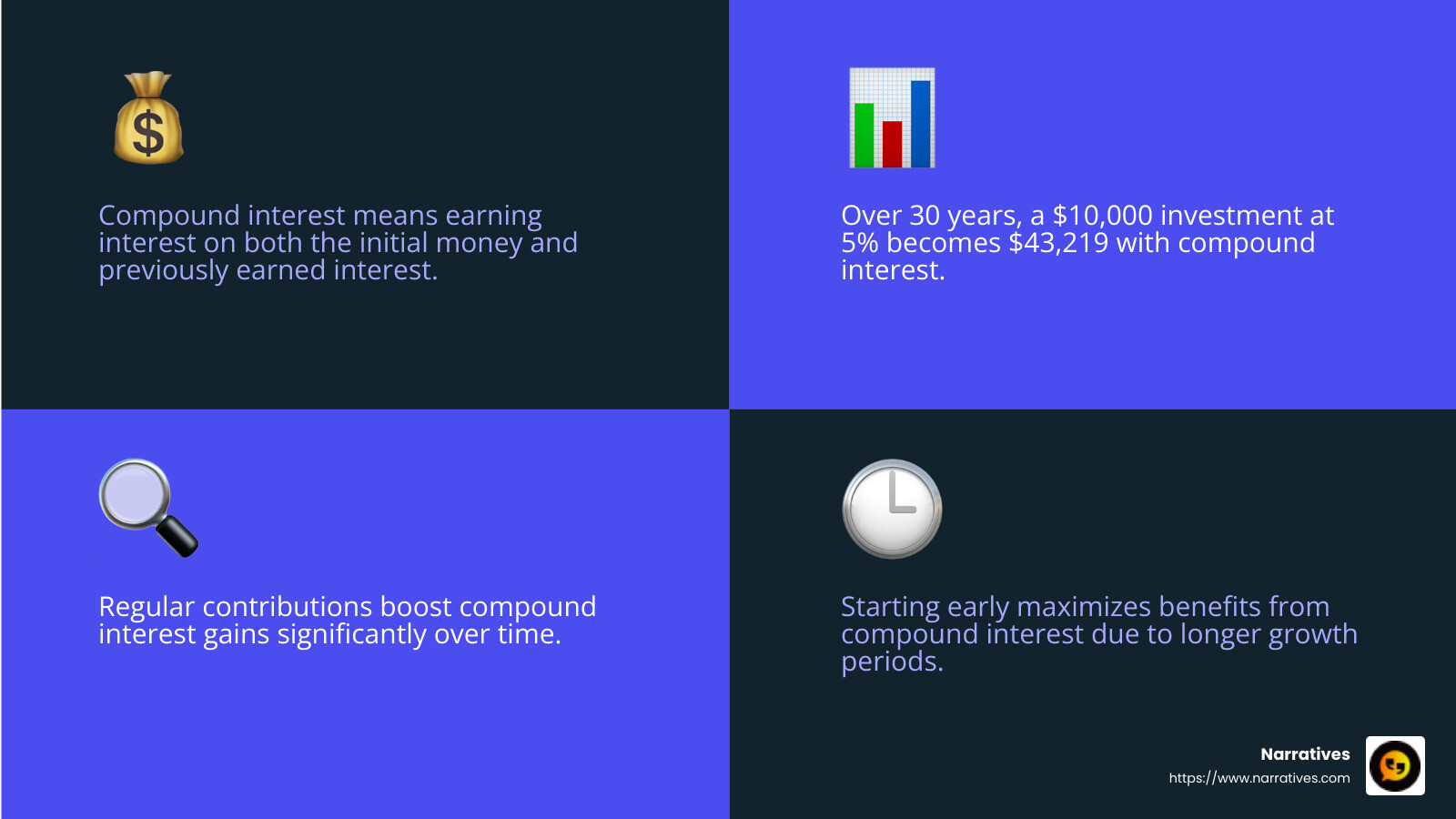Financial Flair: How to Engage on Social Media

Social media content for financial services can transform the way non-profits and social impact organizations connect with their audience. With more people turning to digital platforms for financial advice and information, it's crucial for financial services to engage effectively on social media. By doing so they can amplify their mission and foster meaningful relationships. Here's a quick glance at what this involves:
- Creating relatable and informative content that speaks directly to your audience's needs.
- Choosing the right platforms to reach your target audience effectively. Think LinkedIn, Facebook, and Instagram among others.
- Engaging regularly with your audience to build trust and loyalty.
- Using visual storytelling and video to convey complex financial concepts in an easy-to-understand and engaging manner.
- Showcasing client success stories to provide social proof and highlight the impact of your services.
For social impact organizations, the goal is to make sure your mission resonates authentically through effective digital storytelling. Leveraging social media, you can connect with a wider audience, inspire action, and ultimately make a lasting impact in your community.

Social media content for financial services terms at a glance:
- social media content creation company
- social media marketing for professional services
- social media management strategy
Understanding Social Media Platforms for Financial Services
Navigating the social media landscape can feel overwhelming, especially in the financial services sector. However, understanding the strengths of each platform can help you make informed decisions about where to focus your efforts. Let's explore the top platforms for financial services and how they can amplify your message.
Facebook remains a powerhouse with its vast user base and versatile content options. 97% of banks use Facebook to reach diverse demographics, making it a staple for financial services. The platform excels with video content and curated posts that tell compelling stories. Use it to share financial literacy tips or customer testimonials that resonate with your audience.
- Key Advantage: Broad reach and diverse content formats.
- Best Content: Videos and curated storytelling.
LinkedIn is the go-to platform for professional networking in the financial sector. It's trusted for sharing industry insights and company news. Financial services can leverage LinkedIn to build credibility and connect with clients seeking expert advice. Users are 2X more likely to seek financial advice here than on other platforms.
- Key Advantage: Professional audience and high trust level.
- Best Content: Industry insights and professional content.
Instagram's visual nature makes it ideal for humanizing your brand. It's perfect for showcasing company culture, community initiatives, and visual storytelling. Financial services can use Instagram to simplify complex topics with infographics and engage a younger audience with relatable content.
- Key Advantage: Highly visual and engaging.
- Best Content: High-resolution photos and stories.
YouTube
YouTube is a valuable platform for sharing informative and entertaining video content. Short-form videos can effectively communicate financial concepts and reach a broad audience. The platform is perfect for tutorials, client success stories, and deep dives into financial topics.
- Key Advantage: Engaging video content.
- Best Content: Informative short-form videos.
X (Twitter)
X, formerly known as Twitter, thrives on timely updates and quick interactions. It's ideal for sharing news, blog posts, and engaging with followers in real-time. Financial services can use X to provide quick tips, share industry news, and handle customer inquiries.
- Key Advantage: Real-time engagement and news sharing.
- Best Content: News, blog posts, and timely updates.
Understanding these platforms and their unique strengths allows financial services to craft a social media strategy that resonates with their audience, builds trust, and drives engagement. By choosing the right platform and content, you can effectively communicate your message and connect with clients in meaningful ways.
Creating Effective Social Media Content for Financial Services
Creating social media content for financial services is all about making complex topics accessible and engaging. Let's explore some strategies to craft content that educates, connects, and captivates.
Financial Literacy
Financial literacy is essential. It empowers your audience to make informed decisions. Use straightforward language to explain concepts like budgeting, saving, and investing. Consider creating a series of posts or short videos that break down these topics into bite-sized pieces.
- Tip: Use infographics to simplify data and statistics. For example, show how compound interest works over time.

Visual Storytelling
Visual storytelling helps your audience connect emotionally with your brand. Use high-quality images and graphics to tell stories about client successes or community initiatives. This approach not only humanizes your brand but also makes financial topics more relatable.
- Example: Share a story about a client who overcame financial problems with your help. Use before-and-after visuals to highlight their journey.
Video Content
Video content is king on social media. It captures attention and is highly shareable. Use videos to explain complex financial terms, showcase client testimonials, or provide quick tips. Platforms like YouTube and Instagram are perfect for this.
- Pro Tip: Keep videos short and engaging. Aim for under two minutes to maintain viewer interest.
Client Engagement
Engaging with your audience is crucial. Use social media to ask questions, run polls, or host live Q&A sessions. This interaction builds trust and shows that you value your clients' input.
- Strategy: Create a weekly "Ask Me Anything" session on Instagram Live where clients can ask questions about personal finance.
By focusing on these strategies, you can create social media content for financial services that not only educates but also builds a loyal and engaged community. Up next, we'll explore 12 creative content ideas to keep your social media presence fresh and impactful.
12 Social Media Content Ideas for Financial Services
Ready to boost your social media game? Here are 12 content ideas custom for financial services to engage, educate, and lift your brand.
Financial Health Checklists
Create interactive checklists for different financial goals, like saving for retirement or buying a home. These checklists can help followers track their progress and encourage engagement.
- Engagement Tip: Ask your audience to share their checklist progress in the comments or through a poll.
Investment Explainers
Use infographics to break down complex investment concepts. Make topics like mutual funds or stock market trends easy to understand and shareable.
- Visual Idea: A step-by-step guide on how mutual funds work, using simple graphics.
Tax Season Tips
Offer timely advice during tax season. Share tips on maximizing returns or understanding tax credits, which are highly valuable to your audience.
- Pro Tip: Create a series of short videos explaining common tax deductions.
Budgeting Best Practices
Share budgeting templates or best practices to help followers manage their finances more effectively. Practical advice can empower your audience to take control of their money.
- Content Idea: A downloadable budget planner with tips on sticking to it.
Client Success Stories
Feature stories of how your services have positively impacted clients. Highlight specific financial milestones they’ve achieved.
- Story Example: Showcase a couple who purchased their dream home with your help, complete with their testimonial.
Economic Updates
Provide concise, easy-to-understand updates on economic conditions and how they might affect personal finance. This keeps your audience informed and positions you as a thought leader.
- Fact: Banks that actively manage their online presence see a 19% lift in customer retention.
Live Q&A Sessions
Host live sessions where financial experts answer follower questions. This real-time engagement is invaluable for building trust and community.
- Platform Suggestion: Use Instagram Live for weekly Q&A sessions on trending financial topics.
Financial Myth Busting
Create a series that debunks common financial myths. Provide accurate information to dispel misconceptions and build credibility.
- Myth Example: "You need a lot of money to start investing"—debunk and provide alternatives.
Behind-the-Scenes Content
Share a glimpse into your company culture and the people behind the brand. This humanizes your institution and builds trust.
- Post Idea: "Meet Your Local Lender" with team bios and photos.
Interactive Polls and Quizzes
Engage your audience with polls about financial habits or quizzes that test their financial knowledge. This encourages interaction and learning.
- Quiz Topic: "Test Your Financial Literacy" with questions on saving and investing.
Celebratory Posts
Acknowledge national holidays, awareness days, or finance-related milestones. This connects your brand with broader themes and trends.
- Example: Celebrate National Savings Day with a post on the importance of saving.
By incorporating these ideas, your social media content for financial services can become a powerhouse of engagement and education. Next, we'll explore strategies to ensure your content is compliant and consistent with your brand voice.
Social Media Strategy for Financial Services
Crafting a successful social media strategy for financial services requires balancing creativity with compliance. Here's how to make sure your content not only engages but also adheres to industry standards.
Regulatory Compliance
Staying compliant is non-negotiable. Financial services must steer a maze of regulations to ensure transparency and protect consumer interests. Before hitting "post," make sure your content is reviewed by your legal team. This step helps you avoid pitfalls and maintain trust.
- Tip: Use compliance tools to streamline this process, ensuring every post meets necessary guidelines.
Brand Voice
Your brand voice should reflect your institution's values and connect with your target audience. Whether it's professional, friendly, or a mix of both, consistency is key.
- Example: A wealth management firm might adopt a formal tone, while a community credit union could lean towards a more approachable voice.
Content Variety
Diversifying your content keeps your audience engaged and informed. Mix educational posts with interactive content to maintain interest.
- Content Types: How-to guides, expert tips, industry news, and client stories.
Audience Engagement
Engagement is more than just likes and shares; it's about building relationships. Use social media to interact with your audience, answer questions, and provide value.
- Engagement Tactic: Host live Q&A sessions to address follower queries in real-time. This not only builds trust but also positions your brand as a thought leader.
By focusing on these strategic elements, your social media content for financial services can effectively engage your audience and lift your brand. Next, we'll tackle frequently asked questions about maintaining compliance and maximizing performance on platforms like LinkedIn.
Frequently Asked Questions about Social Media Content for Financial Services
How can financial services ensure compliance on social media?
Regulatory compliance is crucial in the financial sector, especially when using social media. It's essential to adhere to guidelines that ensure transparency and protect consumer interests.
Regulatory Guidelines: Financial institutions must be familiar with and follow regulations such as the SEC's advertising rules or FINRA's social media guidelines. This ensures that all content is accurate and not misleading.
Compliance Tools: Leverage tools designed to help monitor and review social media content for compliance. These tools can automate the process of ensuring that every post meets industry standards, reducing the risk of violations.
What type of content performs best on LinkedIn for financial services?
LinkedIn is a powerful platform for financial services, offering a professional environment to connect with industry peers and potential clients.
Professional Content: Share insights and updates that position your brand as an industry leader. This could include white papers, research reports, or analysis of current financial trends.
Industry Insights: Posts that provide valuable insights into market trends or explain complex financial concepts in simple terms can engage your audience effectively. These posts not only attract attention but also establish your authority in the field.
How can financial advisors use social media to find new clients?
Social media is a dynamic tool for financial advisors to expand their reach and connect with new clients.
Networking: Use platforms like LinkedIn to connect with other professionals and potential clients. Join groups related to financial services to engage in discussions and share your expertise.
Client Engagement: Regularly interact with your audience by responding to comments, hosting webinars, or conducting live Q&A sessions. These interactions not only build relationships but also showcase your commitment to client education and support.
By effectively navigating these aspects, financial services can harness the power of social media to maintain compliance, engage their audience, and ultimately grow their client base.
Conclusion
As we wrap up our exploration of social media content for financial services, it's clear that digital platforms offer immense opportunities for engagement and growth. But to truly stand out, financial services need to go beyond traditional approaches and accept innovative strategies.
This is where Narratives can play a pivotal role. As a leader in digital storytelling, we specialize in crafting compelling narratives that resonate with audiences. Our focus is on elevating underrepresented voices and creating emotionally impactful content. By partnering with us, financial services can not only improve their social media presence but also build deeper connections with their audience.
For non-profits and purpose-driven organizations, the power of storytelling cannot be overstated. By sharing real stories of impact, organizations can inspire action, build trust, and increase visibility. At Narratives, we are dedicated to supporting these organizations in their mission to make a difference.
If you're ready to harness the power of storytelling for your financial services or non-profit organization, explore our media network services and see how we can help you tell your story in a way that truly engages your audience.
In the changing digital landscape, let us be your partner in crafting stories that matter. Together, we can create a future where every voice is heard and every story is told.


